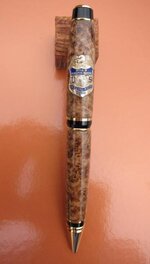Fireengines
Member
I have a badge lapel pen from a federal agency and would like to add it to a pen.
I would like to add it to the pen itelf but would like to bounce my idea off everyone:
Use a wood blank;
Sand the lapel pin down to as thin as possible without losing detail;
Form the pin around the pen;
Using epoxy, glue the pin to the finish RAW wood (no CA applied);
Here is the problem...
I have to cover the pen with CA. However, the pin does have some height and applying CA would build up at the base of the pin in the direction the pen is spinning on the lathe. My solution is to simply reverse the blanks and allow them to spin in the opposite direction and apply the CA. Does this sound like it would work?
Another option is to apply the CA as normal to the pen and glue the badge to the pen after CA application but not to sure how epoxy will stick to the CA.
It may be easier to attach the pin to the clip but I am not sure how secure that would be and how to do it.
I would like to add it to the pen itelf but would like to bounce my idea off everyone:
Use a wood blank;
Sand the lapel pin down to as thin as possible without losing detail;
Form the pin around the pen;
Using epoxy, glue the pin to the finish RAW wood (no CA applied);
Here is the problem...
I have to cover the pen with CA. However, the pin does have some height and applying CA would build up at the base of the pin in the direction the pen is spinning on the lathe. My solution is to simply reverse the blanks and allow them to spin in the opposite direction and apply the CA. Does this sound like it would work?
Another option is to apply the CA as normal to the pen and glue the badge to the pen after CA application but not to sure how epoxy will stick to the CA.
It may be easier to attach the pin to the clip but I am not sure how secure that would be and how to do it.
Last edited:

